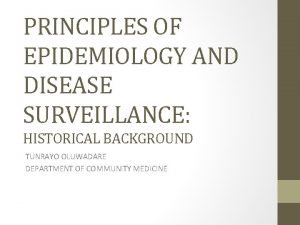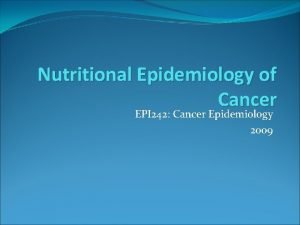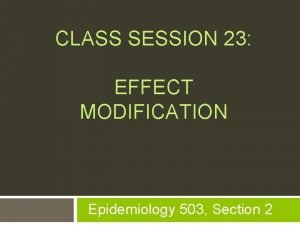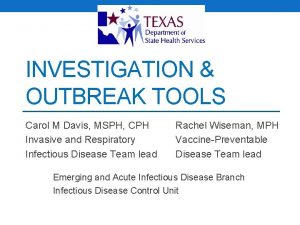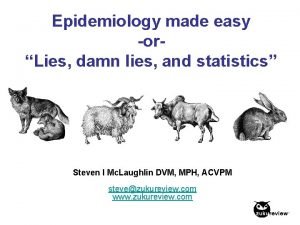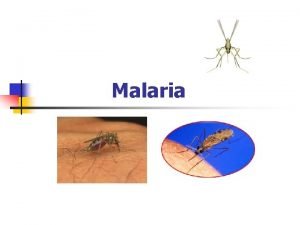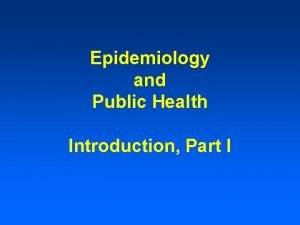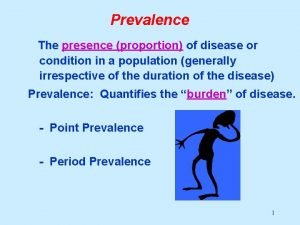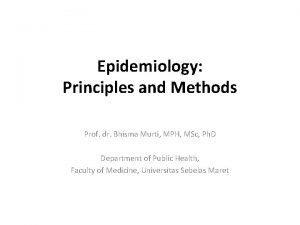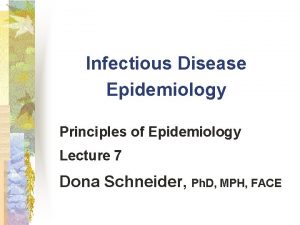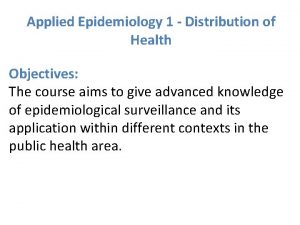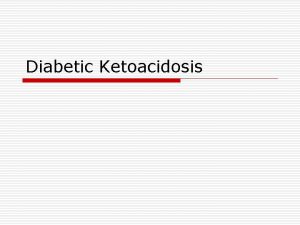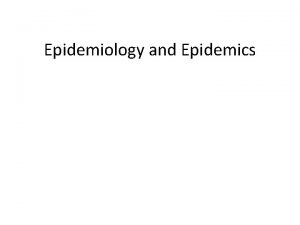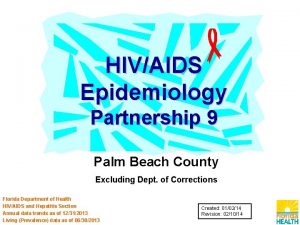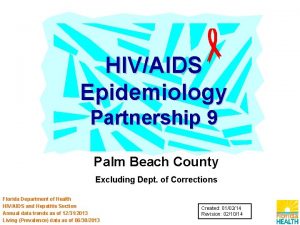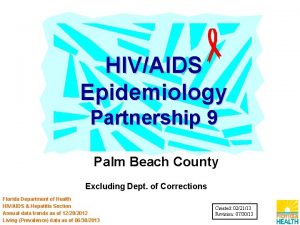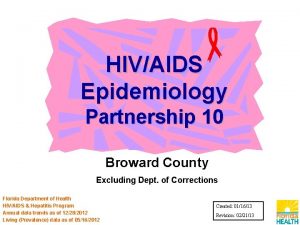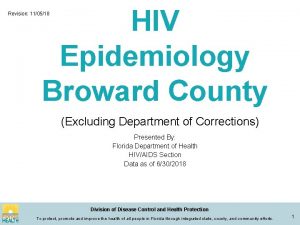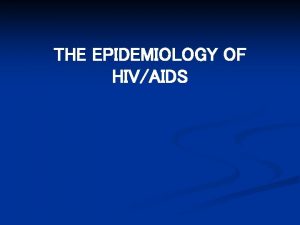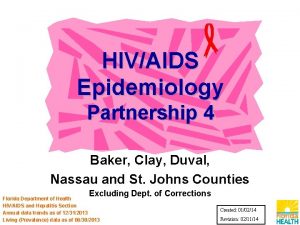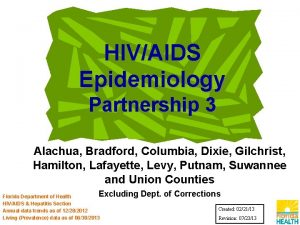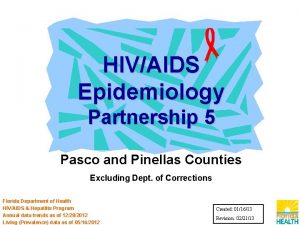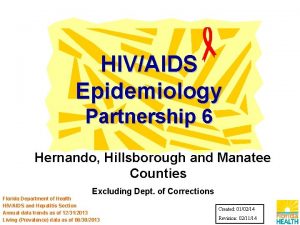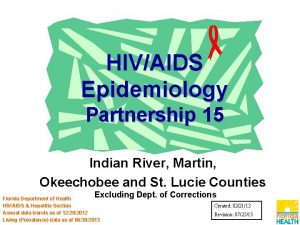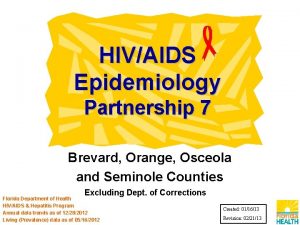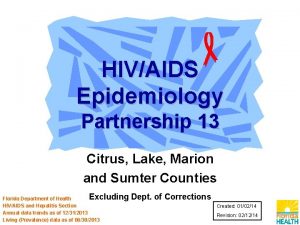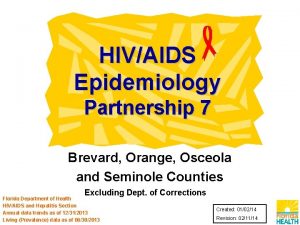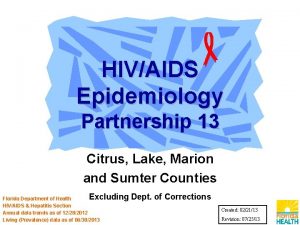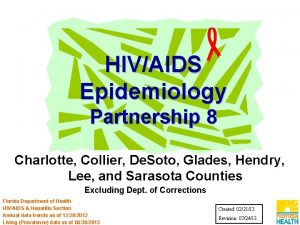HIVAIDS Epidemiology Partnership 11 a MiamiDade County Excluding








































- Slides: 40

HIV/AIDS Epidemiology Partnership 11 a Miami-Dade County Excluding Dept. of Corrections Florida Department of Health HIV/AIDS and Hepatitis Section Annual data trends as of 12/31/2013 Living (Prevalence) data as of 06/30/2013 Created: 01/02/14 Revision: 02/12/14

HIV and AIDS Case Data HIV Infection reporting represents newly reported HIV cases, regardless of AIDS status at time of report. HIV infection cases classified as Stage 3 (AIDS) became reportable in Florida in 1981. HIV infection cases (without an AIDS diagnosis) became reportable in Florida on July 1, 1997. AIDS cases and HIV infection cases by year of report are NOT mutually exclusive and CANNOT be added together. Frozen databases of year-end data are generated at the end of each calendar year. These are the same data used for Florida CHARTS and all grant-related data where annual data are included. HIV prevalence data are prepared later in the year, when most of the “expected” death data are complete, usually in July.

HIV and AIDS Case Data (con’t) Adult cases represent ages 13 and older, pediatric cases are those under the age of 13. For data by year, the age is by age of diagnosis. For living data, the age is by current age at the end of the most recent calendar year, regardless of age at diagnosis. Unless otherwise noted, whites are non-Hispanic and blacks are non-Hispanic. Unless otherwise noted. Area and county data will exclude DOC cases.

Cumulative HIV (not AIDS) and AIDS Cases, Reported through 2013, Partnership 11 a

AIDS Cases and Rates*, by Year of Report, 2004 -2013, Partnership 11 a Enhanced laboratory reporting (ELR) laws in 2006 and the expansion of ELR in 2007 led to an artificial peak in newly reported cases of AIDS in 2008. This was followed by a general decline in reported cases through 2012. Another surge in the expansion of ELR in 2012 was followed by another increase in newly reported cases of AIDS in 2013. These trends were observed across most race/sex/risk groups throughout the state. *Source: Population estimates are provided by Florida CHARTS as of 02/05/2014. Rates are expressed as per 100, 000 population.

HIV Infection Cases and Rates*, by Year of Report, 2004 -2013, Partnership 11 a Note: Enhanced laboratory reporting (ELR) laws in 2006 and the expansion of ELR in 2007 led to an artificial peak in newly reported cases of HIV infection in 2008. This was followed by a general decline in reported cases through 2012. Another surge in the expansion of ELR in 2012 was followed by another increase in newly reported cases of HIV infection in 2013. These trends were observed across most race/sex/risk groups throughout the state. *Source: Population estimates are provided by Florida CHARTS as of 02/05/2014. Rates are expressed as per 100, 000 population.

Adult AIDS Cases, by Sex and Year of Report, 2004 -2013, Partnership 11 a M: F Ratio* Males 2004 2. 2: 1 2013 2. 6: 1 Females Note: AIDS cases tend to represent HIV transmission that occurred many years ago. The relative increases in males cases reflect the changing face of the AIDS epidemic over time. *The male-to-female ratio is the number of cases among males divided by the number of cases among females.

Adult HIV Infection Cases, by Sex and Year of Report, 2004 -2013, Partnership 11 a M: F Ratio* Males 2004 2. 5: 1 2013 3. 5: 1 Females Note: Recent trends in HIV transmission are best described by the HIV case data. The relative increases in male HIV Infection Cases might be attributed to proportional increases in HIV transmission among men who have sex with men (MSM), which may influence future AIDS trends. *The male-tofemale ratio is the number of cases among males divided by the number of cases among females.

Adult AIDS and HIV Infection Cases by Sex, Reported in 2013, Partnership 11 a AIDS N=708 HIV Infection N=1, 432 Note: Partnership 11 a’s Adult Population is: 48% Male and 52% Female.

Adult AIDS Cases by Race/Ethnicity and Year of Report, 2004 -2013, Partnership 11 a Factors Affecting Disparities -Late diagnosis of HIV. Black -Access to/acceptance of care. -Delayed prevention messages. Hispanic White -Stigma. -Non-HIV STD’s in the community. -Prevalence of injection drug use. -Complex matrix of factors related to socioeconomic status Note: In 2013, blacks accounted for 48% of adult AIDS cases, but only 16% of the population. From 2004 to 2013, the proportion of adult AIDS cases increased by 10 percentage points among Hispanics. In contrast, the proportion of adult AIDS cases decreased among whites and blacks by 2 and 6 percentage points, respectively, during the same time period. Numerous disparities can affect the increases of HIV disease in a given population. Other races represent less than 3% of the cases and are not included.

Adult HIV Infection Cases by Race/Ethnicity and Year of Report, 2004 -2013, Partnership 11 a Black Hispanic White Note: HIV case reporting reflects more recent trends in the epidemic with respect to the distribution of cases by race/ethnicity. From 2004 to 2013, the proportion of HIV infection cases among whites and blacks decreased by 1 and 10 percentage points, respectively. In contrast, the proportion of HIV infection cases increased by 11 percentage points among whites, during the same time period. Other races represent less than 2% of the cases and are not included.

Adult Male HIV Infection Cases by Race/Ethnicity and Year of Report, 2004 -2013, Partnership 11 a Hispanic Black White Note: Over the past ten years, Hispanics represented the majority (> 45%) of male HIV infection cases for most of the years. From 2004 to 2013, the proportion of HIV infection cases among blacks and white males decreased by 8 and 2 percentage points, respectively. In contrast, HIV infection cases among Hispanic males increase by 9 percentage points, during the same time period. Other races represent less than 2% of the cases and are not included.

Adult Female HIV Infection Cases by Race/Ethnicity and Year of Report, 2004 -2013, Partnership 11 a Black White Hispanic Note: HIV case disparities are more evident among women than men. For the past ten years, black women represented 67% or more of the cases each year. The proportion of female HIV infection cases decreased by 4 percentage points among black females, from 2004 to 2013. In contrast, the proportion of HIV infection cases increased by 4 percentage points among white females, while the proportion of cases among white females remained the unchanged during the same time period. Other races represent less than 3% of the cases and are not included.

Adult AIDS Case Rates* by Sex and Race/Ethnicity, Reported in 2013, Partnership 11 a Rate Ratios: MALES Black: White, 5. 5: 1 Hispanic: White, 1. 7: 1 FEMALES Black: White, 8. 3: 1 Hispanic: White, 0. 7: 1 Note: Among black males, the AIDS case rate is nearly 6 times higher than the rate among white males. Similarly, among black females, the AIDS case rate is 8 times higher than the rate among white females. Hispanic males have an AIDS case rate that is nearly 2 times higher than the rate among white males. In contrast, Hispanic females have an AIDS case rate that is lower than the rate among white females. *Source: 2013 Partnership 11 a population estimates are provided by Florida CHARTS as of 02/05/2014.

Adult HIV Infection Case Rates* by Sex and Race/Ethnicity, Reported in 2013, Partnership 11 a Rate Ratios: MALES Black: White, 2. 2: 1 Hispanic: White, 1. 0: 1 FEMALES Black: White, 13. 0: 1 Hispanic: White, 1. 3: 1 Note: Among black males, the HIV infection case rate is nearly 2 times higher than the rate among white males. Among black females, the HIV case rate is 13 -fold greater than the rate among white females. Among Hispanic males and females, the HIV case rate is equivalent to the rate among their white counterparts. *Source: Population estimates are provided by Florida CHARTS as of 02/05/2014.

Adult AIDS and HIV Cases Reported in 2013 and Population Data, by Race/Ethnicity, Partnership 11 a 2013 Partnership 11 a Population Estimates* N=2, 157, 061 AIDS N=708 White Black Hispanic HIV Infection N=1, 432 Other** Note: In this snapshot for 2013, blacks are over-represented among the AIDS and HIV infection cases, accounting for 44% of adult AIDS cases and 37% of adult HIV infection cases, but only 16% of the adult population. A group is disproportionately impacted to the extent that the percentage of cases exceeds the percentage of the population. *Source: Population estimates are provided by Florida CHARTS as of 02/05/2014. **Other includes Asian/Pacific Islanders, Native Alaskans/American Indians and mixed races.

Adult HIV Infection Cases, by Age Group at Diagnosis, and Year of Report, 2004– 2013, Partnership 11 a Note: From 2004 to 2013, the proportion of adult HIV infection cases among those aged 20 -29 increased by 12 percentage points.

Adult HIV Infection Cases, by Sex and Age Group at Diagnosis, Reported in 2013, Partnership 11 a Males N=1, 115 Females N=317 Note: HIV infection cases tend to reflect more recent transmission than AIDS cases, and thus present a more current picture of the epidemic. With regard to the age group with the highest percent of HIV infection cases, recent estimates show that among males, 29% of HIV infection cases occur among those aged 20 -29, whereas among females 28% of HIV infection cases occur among those aged 50 and older.

Definitions of Mode of Exposure Categories MSM = Men who have sex with men IDU = Injection Drug Use MSM/IDU = Men who have sex with men & Injection Drug Use Heterosexual = Heterosexual contact with person with HIV/AIDS or known HIV risk OTHER = includes hemophilia, transfusion, perinatal and other pediatric risks and other confirmed risks. NIR = Cases reported with No Identified Risk Redistribution of NIRs = This illustrates the effect of statistically assigning (redistributing) the NIRs to recognized exposure (risk) categories by applying the proportions of historically reclassified NIRs to the unresolved NIRs.

Adult Male HIV Infection Cases, by Mode of Exposure and Year of Report, 2004– 2013, Partnership 11 a Note: NIRs redistributed. Men who have sex with men (MSM) remains as the primary mode of exposure among male HIV cases in Partnership 11 a, followed by heterosexual contact.

Adult Female HIV Infection Cases by Exposure Category and Year of Report, 2004 -2013, Partnership 11 a Note: NIRs redistributed. The heterosexual risk continues to be the dominant mode of exposure among females.

Adult Male AIDS and HIV Infection Cases, by Mode of Exposure, Reported in 2013, Partnership 11 a AIDS N=511 HIV Infection N=1, 115 Note: NIRs redistributed. Among the male AIDS and HIV infection cases reported for 2013, men who have sex with men (MSM) was the most common risk factor (65% and 81% respectively) followed by cases with a heterosexual risk (27% for AIDS and 16% for HIV). The recent increase among MSM is indicated by the higher MSM among HIV infection cases compared to AIDS cases, as HIV infection cases tend to represent a more recent picture of the epidemic.

Adult Female AIDS and HIV Infection Cases, by Mode of Exposure, Reported in 2013, Partnership 11 a AIDS N=197 HIV Infection N=317 Note: NIRs redistributed. Among the female AIDS and HIV infection cases reported for 2013, heterosexual contact was the highest risk (85% and 95% respectively).

Cases Living with HIV Disease

Adults Living with HIV Disease By Zip Code, Reported through 2012, Partnership 11 a Total Living HIV/AIDS Cases 0 1 - 50 51 - 125 126 - 250 Over 250 N=25, 121 NIRs are not redistributed. Excludes DOC, homeless, and cases with unknown zips. Data as of 05/17/2013

Men who have Sex with Men (MSM)* Living with HIV Disease By Zip Code, Reported through 2012, Partnership 11 a Living MSM HIV/AIDS Cases 0 1 - 50 51 - 125 126 - 250 Over 250 N=12, 964 NIRs are not redistributed. Excludes DOC, homeless, and cases with unknown zips. *Includes MSM/IDU cases. Data as of 05/17/2013

Injection Drug Users (IDUs)* Living with HIV Disease By Zip Code, Reported through 2012, Partnership 11 a Living IDU HIV/AIDS Cases 0 1 - 25 26 - 50 51 - 75 Over 75 N=2, 549 NIRs are not redistributed. Excludes DOC, homeless, and cases with unknown zips. *Includes MSM/IDU cases. Data as of 05/17/2013

Adult Heterosexuals Living with HIV Disease By Zip Code, Reported through 2012, Partnership 11 a Living Heterosexual HIV/AIDS Cases 0 1 - 50 51 - 125 126 - 250 Over 250 N=9, 902 NIRs are not redistributed. Excludes DOC, homeless, and cases with unknown zips. Data as of 05/17/2013

Adults Living with HIV Disease By Zip Code and Race/Ethnicity, Reported through 2012, Partnership 11 a 1 Dot = 3 cases Dots are randomly placed within zip codes. Hispanic Black, not-Hispanic White, not-Hispanic N=24, 756 Total includes all races, some which are not on map. Excludes DOC, homeless, and cases with unknown zips. Data as of 05/17/2013

Adults Living with HIV Disease By Zip Code and Sex, Reported through 2012, Partnership 11 a 1 Dot = 3 cases Dots are randomly placed within zip codes. Male Female N=25, 121 Excludes DOC, homeless, and cases with unknown zips. Data as of 05/17/2013

Adults Living with HIV Disease, by Sex and Race/Ethnicity Reported through 2012, Partnership 11 a Males Females N=18, 237 N=7, 307 Note: Among adult males living HIV disease, Hispanics represent the race most affected (48%). Among adult females, blacks represent the race most affected (71%). *Other includes Asian/Pacific Islanders and Native Alaskans/American Indians.

Case Rates* of Adults Living with HIV Disease, by Sex and Race/Ethnicity, Reported through 2012, Partnership 11 a RATE RATIOS: MALES Blacks: Whites, 2. 3: 1 Hispanics: Whites, 0. 7: 1 FEMALES Black: Whites, 12. 5: 1 Hispanics: Whites, 1: 1 Note: Among black males living with HIV disease reported through 2012, the case rate is 2 times higher than the rate among white males. Among black females living with HIV disease, the case rate is nearly 13 times higher than the rate among white females. The Hispanic male rate is lower than the rate among their white counterpart, whereas the Hispanic female rate is equivalent to the rate among their white counterpart. Data excludes Department of Corrections cases. *Source: Population estimates are provided by Florida. CHARTS. **Other includes Asian/Pacific Islanders and Native Alaskans/American Indians.

Adult Males Living with HIV Disease by Race/Ethnicity and Mode of Exposure Reported through 2012, Partnership 11 a White Non-Hispanic, N=2, 850 Black Non-Hispanic, N=6, 380 Hispanic, N=8, 735 Note: NIRs redistributed. Among males living with HIV disease, the distribution of risk among blacks differs from that among whites and Hispanics. MSM represents the highest risk for all races. White males have the smallest proportion of heterosexual contact cases.

Adult Females Living with HIV Disease by Race/Ethnicity and Mode of Exposure Reported through 2012, Partnership 11 a White Non-Hispanic, N=354 Black Non-Hispanic, N=5, 206 Hispanic, N=1, 637 Note: NIRs redistributed. Among females living with HIV disease, the distribution of risk among whites differs from that among blacks and Hispanics. Heterosexual contact is the majority risk for all races. However, whites have the largest proportion of IDU cases.

Annual Prevalence of Adults Living with HIV Disease, 1995 -2012, Partnership 11 a As a result of declining deaths, annual HIV/AIDS diagnoses have exceeded deaths since 1995, and the number of persons reported with HIV/AIDS that are presumed to be alive has been increasing. Since the year 1995, prevalent cases have increased by over 385%. In 2012, the prevalence increased by 4% since the previous year.

Number and Percentage of HIV-Infected Persons Engaged in Selected Stages of The Continuum of HIV Care — Partnership 11 a, 2012 • HIV-infected=HIV diagnosed cases divided by 84. 2% (to account for 15. 8% national estimated unaware of their status in Florida). The 2011 indicator report (http: //www. cdc. gov/hiv/pdf/2011_Monitoring_HIV_Indicators_HSSR_FINAL. pdf ) estimates that 15. 8% are undiagnosed (Table 9 a) – this report uses 2010 data and was published in October 2013. • HIV Diagnosed=Number of cases known to be alive and living in Florida through 2012, regardless where diagnosed, as of 06/30/2013 (used for unmet need calculations ), plus an additional 4% to account for OOS in care, but not yet entered into e. HARS. • Linked to Care (Ever in Care) =Based on calculated data of persons living with HIV disease in Florida (regardless of where diagnosed) who ever had a CD 4 or Viral load test in the e. HARS dataset. (National estimates are 77%). • In Care this Year=Based on Unmet need calculations as prescribed by HRSA, for persons living with HIV in Florida (regardless of where diagnosed) and having at least 1 HIV-related care service involving either a VL or CD 4 test, or a refill of HIV-related RX, plus 5% for unreported/missing labs and plus 6% for OOS cases known in care, but not yet entered into e. HARS. (National estimates for in care 57%). • On ART=Estimated 92. 7% of In care this year in Florida per MMP (National estimates are 88%) • Suppressed VL=Estimated 76. 1% on ART are in care this year in Florida per MMP (National estimates are 77%).

Resident Deaths due to HIV Disease, by Year of Death, 1995 -2012, Partnership 11 a These data represent a 82% decline in HIV Resident Deaths due to HIV Disease from the peak year of 1995 to 2012. This is slightly higher than the 79% decline observed by the state. Source: Florida Department of Health, Bureau of Vital Statistics, Death Certificates (as of 05/07/13). Population data are provided by Florida. CHARTS. *Other includes Asian/Pacific Islanders, Native Alaskans/American Indians and mixed races.

Some Useful Links CDC HIV/AIDS Surveillance Reports (State and Metro Data): http: //www. cdc. gov/hiv/stats/hasrlink. htm MMWR (Special Articles on Diseases, Including HIV/AIDS): http: //www. cdc. gov/mmwr/ U. S. Census Data (Available by State, County): http: //www. census. gov Partnership 11 a Dept. of Health, HIV/AIDS & Hepatitis Program Website (Slide Sets, Fact Sheets, Monthly Surveillance Report, Counseling & Testing Data, etc. ): http: //www. doh. state. fl. us/disease_ctrl/aids/index. html

“The reason for collecting, analyzing and disseminating information on a disease is to control that disease. Collection and analysis should not be allowed to consume resources if action does not follow. ” --Foege WH et al. Int. J of Epidemiology 1976; 5: 29 -37

For Florida HIV/AIDS Surveillance Data Contact: (850) 245 -4444 Lorene Maddox, MPH Tracina Bush, BSW Madgene Moise, MPH Ext. 2613 Ext. 2612 Ext. 2373 Visit Florida’s internet site for: Monthly Surveillance Reports Slide Sets and Fact Sheets Annual Reports and Epi Profiles http: //www. doh. state. fl. us/disease_ctrl/aids/trends. html Visit CDC’s HIV/AIDS internet site for: Surveillance Reports, fact sheets and slide sets http: //www. cdc. gov/hiv/topics/surveillance/resources/reports/index. htm
 Bidsync miami dade
Bidsync miami dade Miamidade county schools
Miamidade county schools Celiac beri beri
Celiac beri beri Temporal relationship epidemiology example
Temporal relationship epidemiology example Nutritional epidemiology
Nutritional epidemiology Gordon nichols
Gordon nichols Descriptive vs analytic epidemiology examples
Descriptive vs analytic epidemiology examples Defination of epidemiology
Defination of epidemiology Epidemiology definition
Epidemiology definition Difference between descriptive and analytical epidemiology
Difference between descriptive and analytical epidemiology Epidemiology definition
Epidemiology definition Effect modification epidemiology
Effect modification epidemiology Define nutritional epidemiology
Define nutritional epidemiology Field epidemiology ppt
Field epidemiology ppt Ramboman acronym
Ramboman acronym Orlies
Orlies Attack rate epidemiology formula
Attack rate epidemiology formula Gametocytes of plasmodium
Gametocytes of plasmodium Epidemiology kept simple
Epidemiology kept simple Formula for attack rate
Formula for attack rate Distribution in epidemiology
Distribution in epidemiology Define epidemiology
Define epidemiology Descriptive vs analytical epidemiology
Descriptive vs analytical epidemiology Period prevalence formula
Period prevalence formula Aims of epidemiology
Aims of epidemiology Logistic regression epidemiology
Logistic regression epidemiology Wheel model of causation
Wheel model of causation Attack rate
Attack rate Distribution in epidemiology
Distribution in epidemiology Diabetic ketoacidosis epidemiology
Diabetic ketoacidosis epidemiology Difference between descriptive and analytical epidemiology
Difference between descriptive and analytical epidemiology What is descriptive study in epidemiology
What is descriptive study in epidemiology Epidemiology triad
Epidemiology triad Bibliography of epidemiology
Bibliography of epidemiology How dr. wafaa elsadr epidemiology professor
How dr. wafaa elsadr epidemiology professor Certification board of infection control and epidemiology
Certification board of infection control and epidemiology Prevalence rate formula
Prevalence rate formula Proportion defination
Proportion defination How dr. wafaa elsadr epidemiology professor
How dr. wafaa elsadr epidemiology professor Person place and time model in epidemiology
Person place and time model in epidemiology Ramboman
Ramboman


